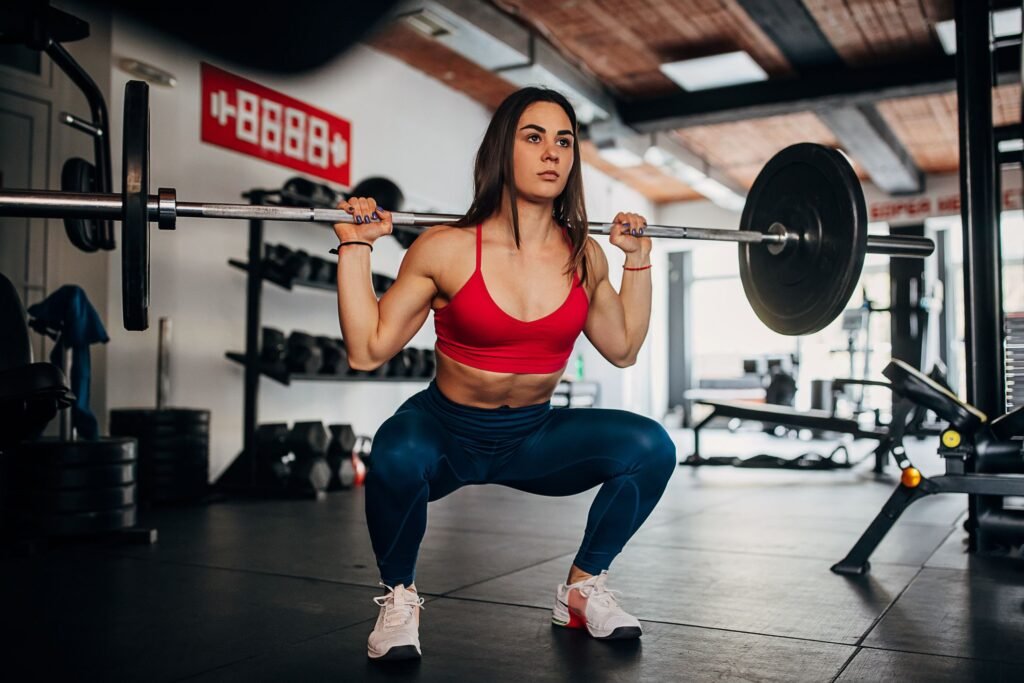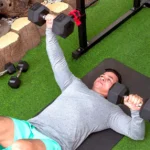
Barbell squats are among the most key and powerful practices in strength preparing. This compound development draws in various muscle gatherings, upgrades balance, increments strength, and can assist with further developing stance and versatility. In this article, we’ll cover all that you want to realize about barbell squats, from their advantages to varieties, legitimate procedure, and tips to boost execution while forestalling wounds.
1. What Are Barbell Squats?
Barbell squats are a type of solidarity preparing that include bringing down the body by twisting the knees and hips while holding a barbell across the upper back. As a compound activity, squats work a few muscles, including the quadriceps, hamstrings, glutes, and center muscles. This exercise is a staple in powerlifting, lifting weights, and general wellness schedules, offering a full-body exercise with an essential spotlight on the lower body.
2. Advantages of Barbell Squats
There are various advantages related with consistently integrating barbell squats into your gym routine. The following are a portion of the key benefits:
a. Fabricates Bulk
Barbell squats target enormous muscle gatherings like the quads, glutes, and hamstrings, making them profoundly successful for developing fortitude and size. Customary practice can prompt observable muscle development and definition.
b. Improves Utilitarian Strength
Squats emulate normal developments like sitting and standing. By further developing strength in these movements, barbell squats upgrade your useful wellness, making ordinary undertakings simpler.
c. Helps Calorie Consume
Since barbell squats draw in various muscle gatherings, they require huge energy use, assisting with consuming calories and aid fat misfortune when joined with a legitimate eating regimen.
d. Further develops Center Strength
The center assumes a basic part in settling the body during squats. Accordingly, barbell squats fortify the muscles in the mid-region and lower back, which can further develop stance and equilibrium.
e. Increments Hormonal Creation
Barbell squats can set off the arrival of chemicals like testosterone and development chemical, which assume a fundamental part in muscle fix and improvement.
3. Kinds of Barbell Squats
There are different kinds of barbell squats that attention on various parts of the body or preparing objectives. Understanding these varieties will assist you with fitting your exercise to your particular requirements.
a. High-Bar Back Squat
This is the most well-known variety, where the barbell is put high on the trapezius muscles. It accentuates quadriceps initiation, making it ideal for building solid legs.
b. Low-Bar Back Squat
In this variety, the barbell is put lower on the back, simply over the shoulder bones. This moves the concentration to the back chain — especially the glutes and hamstrings — and can assist with lifting heavier loads.
c. Front Squat
Here, the barbell lays on the facade of the shoulders, held set up by folding your arms or utilizing an Olympic grasp. Front squats put more noteworthy accentuation on the quads and center, while diminishing burden on the lower back.
d. Zercher Squat
In the Zercher squat, the barbell is held in the law breaker of the elbows as opposed to on the shoulders. This variety puts more spotlight on the center and upper back while as yet working the lower body.
e. Above Squat
The above squat includes holding the barbell above while playing out the squat. This is a high level variety that requires huge shoulder portability and center dependability. It challenges your equilibrium and by and large body coordination.
4. Muscles Worked by Barbell Squats
Barbell squats are known for their full-body influence, yet they especially focus on the accompanying muscle gatherings:
a. Quadriceps
The quadriceps, or quads, are the muscles at the front of your thighs. Barbell squats put critical pressure on these muscles, assisting with developing fortitude and mass.
b. Hamstrings
Situated at the rear of your thighs, hamstrings aid knee flexion and hip augmentation. They assume a fundamental part in settling your developments during squats.
c. Glutes
Your gluteal muscles, especially the gluteus maximus, are vigorously associated with the squat development. These muscles are vital for hip augmentation and produce a large part of the power during squats.
d. Center
The center muscles settle the middle during the barbell squat, forestalling unnecessary forward lean and keeping the spine in a protected, unbiased position.
e. Lower Back (Erector Spinae)
The lower back muscles work to keep your spine erect all through the squat, especially during weighty lifts.
f. Calves
Albeit less involved than different muscles, the calves help with giving solidness and power while remaining back up.
5. Legitimate Structure and Procedure
Executing barbell squats with legitimate structure is significant to stay away from injury and expand results. Here is a bit by bit manual for guarantee right method:
Stage 1: Set Up the Barbell
- Load the barbell with a suitable load on the squat rack, guaranteeing that it is at shoulder level.
- Stand straightforwardly under the barbell, setting it across the upper snares (for high-bar squat) or marginally lower (for low-bar squat).
- Grasp the bar marginally more extensive than shoulder-width separated with your palms looking ahead.
Stage 2: Get Into Position
- Stand with feet shoulder-width separated, toes marginally brought up.
- Draw in your center by fixing your stomach muscles and keeping an impartial spine.
- Lift the barbell off the rack by standing straight up, and make a couple of little strides in reverse to make space.
Stage 3: Drop Into the Squat
- Start the plummet by pushing your hips back as though you’re sitting into a seat.
- Keep your chest upstanding and knees following in accordance with your toes.
- Lower yourself until your thighs are lined up with the floor or just underneath (contingent upon adaptability).
Stage 4: Stand Up
- Push through your heels to get back to the standing position, keeping your center tight and chest lifted.
- Guarantee your knees don’t buckle internal as you rise.
Stage 5: Rehash
- Rehash the development for the ideal number of redundancies.
6. Normal Mix-ups to Keep away from
To benefit from your barbell squat activities and forestall wounds, keeping away from these normal mistakes is fundamental:
a. Allowing Knees To buckle Internal
When hunching down, your knees ought to follow in accordance with your toes. Allowing them to buckle internal, known as “knee valgus,” can overburden the knees and lead to injury.
b. Adjusting the Lower Back
Keeping an impartial spine is basic during the squat. Adjusting your back comes down on your lower spine and expands the gamble of injury.
c. Lifting Excessively Weighty
Beginning with a lot of weight can think twice about structure. Dominating the squat strategy before bit by bit expanding the load is significant.
d. Not Crouching sufficiently low
Halfway squats diminish the scope of movement and may restrict the adequacy of the activity. Hold back nothing equal profundity (where your thighs are lined up with the floor).
e. Taking Your Heels Off the Ground
Your heels ought to stay level on the ground all through the development. Lifting your heels lessens your strength and overwhelms your knees.
7. Tips to Further develop Your Barbell Squats
Here are a few hints to upgrade your squat presentation and develop fortitude over the long haul:
a. Portability Work
Further developing portability in your hips, lower legs, and thoracic spine will upgrade your squat profundity and structure. Extending and dynamic warm-ups before squats can expand your scope of movement.
b. Warm Up Appropriately
Prior to bouncing into weighty squats, play out a dynamic get ready to enact your muscles and increment blood stream. Consider doing light bodyweight squats or obstruction band works out.
c. Begin With a Legitimate Weight
Moderate over-burden is vital, yet don’t begin excessively weighty. Start with a lighter weight and step by step increment as your structure and strength get to the next level.
d. Center around Relaxing
Breathing assumes a significant part in soundness. Work on “supporting” by taking a full breath prior to slipping, holding it as you hunch down, and breathing out as you stand back up.
e. Reinforce Supporting Muscles
Practices like jumps, deadlifts, and center exercises can assist with reinforcing the muscles that help your squat, making you more steady and lessening the gamble of injury.
8. Injury Avoidance and Recuperation
Barbell squats, when performed accurately, are protected and viable. In any case, wrong structure or exorbitant weight can prompt wounds. This is the way to forestall injury and recuperate appropriately:
a. Pay attention to Your Body
Focus on any indications of uneasiness or agony. Pushing through agony can deteriorate wounds. In the case of something feels off, stop the activity and reevaluate your structure.
b. Rest and Recuperation
Permit your muscles sufficient chance to recuperate between squat meetings. Rest days and appropriate sustenance are fundamental for muscle development and injury avoidance.
c. Work on Adaptability
Further developing adaptability through extending activities can assist with forestalling strains or tears, particularly in the hips and lower back.
d. Utilize a Spotter or Security Rack
In the case of lifting weighty, particularly for one-rep max endeavors, consistently utilize a spotter or wellbeing rack to forestall injury in the event of disappointment.
End
Barbell squats are a fundamental part of any wellness routine pointed toward developing fortitude, bulk, and utilitarian wellness. With legitimate structure and strategy, they furnish a full-body exercise with an emphasis on the lower body. By integrating different squat varieties, heating up actually, and focusing on recuperation, you can expand the advantages of barbell squats while limiting the gamble of injury.

